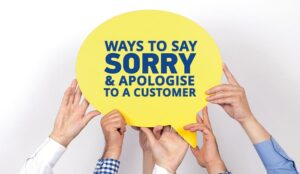Do you think your call centre is offering the best service it possibly can? Think before you answer. Your first instinct is probably, “Yes, of course! How dare you!” but are you really being brutally honest with yourself?
To optimize customer service, you need to know precisely what the term means and how to identify poor service in your own call centre.
If your service isn’t up to scratch, customers won’t stick around, costing your organization opportunities for growth and significantly damaging the bottom line.
In fact, a recent study from Customer Contact Week Digital found that “60% of consumers say they would switch to a competitor after just one or two bad experiences”. If your contact centre is going to survive, you need to match these expectations—if it’s going to thrive, you need to exceed them.
What Qualifies as Bad Customer Service?
In simple terms, poor customer service refers to a company failing to meet customer expectations around its products or services.
This could be in terms of quality, response time, follow-up, or any number of factors that influence the overall customer experience.
When a customer feels their expectations have not been met, they will, of course, be less likely to give you their business again in the future.
With this in mind, you need to be aware of what constitutes bad service. This is the first step towards improving service levels and retaining customers by cementing their loyalty.
Bad customer service can come from many areas, including:
- Agents: Poor agent performance is a significant contributor to bad customer service. If agents are rude, lack product knowledge, or fail to show initiative when it comes to finding solutions, they’re not likely to meet customer expectations.
- Processes: No matter how enthusiastic and knowledgeable an agent is, if they’re stuck in an inefficient system, they’ll struggle to satisfy customers. From call centre staffing to workflows, the onus is on management to organize their resources most effectively. Otherwise, customers will face long wait times, constant transfers, and impersonal service.
- Technology: A call centre needs the right tools to provide a high level of customer service. Low-quality headsets, outdated QA software, and poorly-designed bots are just some examples of technology failing to serve the contact centre.
3 Examples of the Worst Possible Customer Service
Let’s take a look at some examples of the worst possible customer service. This will help clarify what we mean when we speak about bad customer service and, given some of the names on this list, remind us that every organization is susceptible to falling short when it comes to customer service.
Comcast
Comcast has faced frequent customer complaints as a result of recurring outages and lengthy lag times across a number of its services. Perhaps the most egregious example is the story of customer Ryan Block trying to terminate his Comcast contract.
Block recorded the disastrous call and shared it online, leading to a wave of disgruntled Comcast customers sharing their experiences of the company’s poor service. Comcast did apologize eventually, but the damage was done.
AT&T
AT&T is another company that faces a lot of customer complaints. The telecommunications provider has irked customers with a range of service problems, from failed calls and poor coverage to increases in data rates.
As a result of these service problems, AT&T’s contact centre is inundated with calls, and if the reviews appearing online are anything to go by, the company’s customer support has service problems of its own.
AOL
AOL might be a blast from the past for many of us, but plenty of people can still recall the company’s notoriously poor customer service back in its heyday.
Many customers reported negative experiences when dealing with the company’s support, particularly when trying to cancel their accounts.
One customer recalls being asked for his father’s death certificate as he attempted to cancel the family account. Not the best example of empathetic service from AOL.
How to Know When Your Customer Service Is Bad
Deep down, if your customer service is bad, you probably have some inkling already. However, it’s important to take action based on actual data, and there are certain things you can keep an eye on to determine the quality of your call centre’s service.
For example, your customer retention rate is a huge indicator of the standard of service. If customers are consistently receiving poor service, they’re not likely to stick around, and if this is the case, your customer lifetime value will also take a huge hit.
Additionally, extra touchpoints per customer generally indicate a failure to resolve issues efficiently. The old favorites, CSAT and NPS, are also indicators of poor service; low scores in either are a sign that something is amiss.
Perhaps the clearest sign of bad customer service is first-hand testimony. If customer feedback is highlighting a consistent pattern of poor service in your call centre, then it’s time to investigate.
I’ll Do Better: How to Improve Your Customer Service
Okay, so you’ve found out that your customer service is below par. What do you do? The best approach to improving customer service standards will vary to some extent based on the specifics of your organization and the industry you’re operating in, but there are some generally applicable approaches.
Guidelines
Clarity is key. Establishing clear guidelines and reinforcing the importance of service throughout the organization will feed into day-to-day agent activities.
Keep agents in the loop on product updates and business developments to encourage engagement and boost morale.
Priorities
According to Gartner, “CX drives over two-thirds of customer loyalty, outperforming brand and price combined.”
Given the significance of CX in retaining customers, your organization should prioritize accordingly, ensuring that CX and CS teams receive the support necessary to deliver exceptional service.
Training
Regular, ongoing training with consistent feedback goes a long way to keeping agents at the top of their game.
By identifying areas for improvement and assigning tasks accordingly, agents will be empowered to up their service game. This begins from day one with a strong onboarding process outlining the importance of CX and defining best practices.
Process
To keep wait times low, ensure agent productivity, and avoid excessive transfers, you need to manage your contact centre effectively.
Clearly-defined processes, automation of repetitive tasks, and optimized scheduling will enable agents to do their best work.
Communication
Communication is key in every area of the call centre. You need to provide customers with an omnichannel experience, allowing them to reach out where they want when they want.
Additionally, you should ensure that communication between agents, supervisors, and departments is straightforward. Crossed wires can limit access to information and impact the customer journey.
Feedback
In the next section, we will cover the best ways to get honest customer feedback. But it’s not enough to simply gather feedback—you need to analyze it to understand how agents are interacting with customers and what could be improved.
If the same issues are popping up in reviews over and over again, it’s probably time to take a closer look at what is going wrong.
Attitude
A positive attitude right from the start establishes the right tone for the whole conversation, conveying to the customer that the agent not only wants to help but is capable of finding a solution.
Empathy and emotional intelligence are key characteristics of a good agent and should be assessed in the hiring process. Ultimately, agents should be accountable, flexible, and adaptable.
Scorecards
Scorecards can be customized to evaluate any aspect of agent performance, from conversational demeanor to regulatory compliance.
Using scorecards, you can identify areas for improvement and design training programs based on these weaknesses. This takes the guesswork out of coaching and guarantees that you focus on areas that impact customer service most significantly.
How to Make Sure Customers Provide Honest Feedback
You may be familiar with the phrase, “If you don’t have anything nice to say, don’t say anything at all.” Well, some customers abide by that saying.
Getting the whole truth can be tricky, particularly if the customer has an ongoing relationship with your organization.
It’s up to you to collect feedback in a manner that encourages clients to share their opinions openly. Thankfully, in 2022, there are plenty of tools for gathering customer feedback.
Calls
Calling and asking for a testimonial is a simple approach. Ideally, you should get someone with no prior relationship with the customer to reach out. This way, their response will likely be based on their overall experience and not colored by any personal relationships.
Social Media
We all know that social media is the home of unfiltered opinions, so while it is a bit unstructured, the lack of a filter can lead to more honest feedback. Examine your own channels and search for mentions of your organization elsewhere to find out what people are saying online.
Reviews
Third-party review sites are an excellent source of customer feedback. The process doesn’t involve your call centre directly, so customers won’t feel pressure to be positive.
On top of this, third-party sites typically use a verification process, so you can be sure that the reviewers are legitimate customers.
Surveys
Surveys are particularly useful as they can be designed to focus on specific areas, such as CX or agent performance. Have a clear objective, be precise in your questioning, and keep it simple.
A short, to-the-point survey will gather more responses than a meandering, long-winded questionnaire. You can also keep surveys anonymous to encourage honesty.
Interviews
Reaching out to customers directly and requesting an interview is another direct approach to gathering feedback. You can begin the interview in an open-ended fashion and gradually get more specific to home in on your focus areas.
An interview invites a level of back-and-forth that other approaches don’t, encouraging conversation. This kind of qualitative approach gives context to quantitative data you may have gathered elsewhere.
Analytics
By using a conversational analytics tool, you can evaluate 100% of agent–customer interactions across every channel (email, tickets, social media, live chat, etc.) to uncover hidden insights.
Instead of a small sample, this gives you an overview of customer sentiment across every interaction, ensuring greater data accuracy and better decision-making.
How Can Peer-to-Peer Reviews Help With Bad Customer Service?
Peer-to-peer reviews are sometimes overlooked as a means of evaluating service standards, but they can provide unique insights that you’re unlikely to get from other sources.
With peer-to-peer scoring, you can get an on-the-ground performance analysis from someone who knows exactly what it takes to do the job.
Agents may have a better idea of what feedback is most beneficial when it comes to improving performance and may be better equipped to articulate this feedback in an evaluation.
A peer-to-peer approach also encourages agents to take a more active role in their development and gives them a greater awareness of their responsibilities when it comes to customer service.
You can also combine peer-to-peer scoring with more traditional evaluations as a means of verification. For example, a supervisor may want to review some peer-to-peer evaluations for quality control.
Ultimately, the peer-to-peer approach encourages collaboration and teamwork, frees up time and resources, and empowers agents in their roles.
When it comes to conducting these peer-to-peer reviews, scorecards are the best tool to use, as they can be customized for specific requirements and easily shared among team members for real-time feedback.
Final Thoughts
The importance of customer service is undeniable. Bad customer service damages customer retention, lowers CSAT and NPS, limits company growth, and eats into the bottom line.
Thankfully, given the far-reaching impact of poor service, there are plenty of ways to identify it within an organization, whether it’s a flood of negative customer reviews or sinking KPIs. If your service falls below the expected standard, the important thing is to take swift action.
This blog post has been re-published by kind permission of Scorebuddy – View the Original Article
For more information about Scorebuddy - visit the Scorebuddy Website
Call Centre Helper is not responsible for the content of these guest blog posts. The opinions expressed in this article are those of the author, and do not necessarily reflect those of Call Centre Helper.
Author: Scorebuddy
Published On: 18th Nov 2022 - Last modified: 22nd Nov 2022
Read more about - Guest Blogs, Scorebuddy






 Scorebuddy is quality assurance solution for scoring customer service calls, emails and web chat. It is a dedicated, stand-alone staff scoring system based in the cloud, requiring no integration.
Scorebuddy is quality assurance solution for scoring customer service calls, emails and web chat. It is a dedicated, stand-alone staff scoring system based in the cloud, requiring no integration. 









